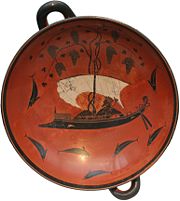
Eye-cup
Encyclopedia

Kylix
Kylix may mean:* Kylix , a genus of snails in the family Drilliidae.*Kylix , a type of drinking cup used in ancient Greece*Kylix , a programming tool...
in terms of shape, they were especially widespread in Athens
Athens
Athens , is the capital and largest city of Greece. Athens dominates the Attica region and is one of the world's oldest cities, as its recorded history spans around 3,400 years. Classical Athens was a powerful city-state...
and Chalkis in the second half of the sixth century BC.
The bowl of the eye-cup rests on a short squat foot; both sides are dominated by large painted pairs of eyes under arched eyebrows. The eyeballs are painted in silhouette style, later often filled with white paint or painted white on black. Some eyes are “female”, i.e. almond-shaped and without tear-ducts. Often, a stylized nase is placed centrally between the eyes. While used as a drinking vessel, due to the necessary inclination of the vessel, the cup with its painted eyes, the handles looking like ears and the base of the foot like a mouth, would have resembled a mask. Many of the vases also bear dionysiac imagery.
The eyes are assumed to have served an apotrophaic (evil-averting) function.
Eye-cups were painted by various painters, mostly in the black-figure style, but later also in the red-figure technique. The earliest bilingual vases
Bilingual vase painting
Bilingual vase painting is a special form of ancient Greek vase painting. The term, derived from linguistics is an essentially metaphorical one; it describes vases that are painted both in the black-figure and in the red-figure techniques...
include specimens of eye-cups with a black-figure interior and a red-figure exterior.
The introduction of this type and ist specific decration into Attic vase painting is attributed to Exekias
Exekias
Exekias was an ancient Greek vase-painter and potter, who worked between approximately 550 BC - 525 BC at Athens. Most of his vases, however, were exported to other regions of the Mediterranean, such as Etruria, while some of his other works remained in Athens. Exekias worked mainly with a...
. His eye-cup in Munich, dated 530-540 BC, is considered a masterpiece of the type. It depicts Dionysos, lying in a symposiast posture on a ship. His divine nature is indicated by his attributem, a vine, growing from the mast.
Other well-known examples of eye-cups are by the following painters or groups:
- Amasis;he painted several eye-cups of a variant shape with non-carinated profile (Type B)
- Andokides
- Antiphon PainterAntiphon PainterThe Antiphon painter was an Athenian vase painter of the early 5th century BC. He owes his name to a double Kalos inscription of Antiphon on the dinos stand in the Antique collection of Berlin . He was active between 500 and 475 BC in Athens as a painter of the red figure style in the largest...
- Epiktetos with bilingual eye-cups
- Ghost Painter
- Painter of the Nicosia Olpe
- Hischylos
- Krokotos Group
- Leafless Group; they continued the basic eye-cup shape with later variants, often lacking the large pair of eyes.
- Lydos GroupLydosLydos was an Attic vase painter in the black-figure style. Active between '’circa’’ 560 and 530 BC, he was the main representative of the '’’Lydos Group’’’ ....
- Lysippides PainterLysippides PainterThe Lysippides Painter was an Attic vase painter in the black-figure style. He was active around 530 to 510 BC. His real name is not known.- Life and work :...
- Mastos PainterMastos PainterThe Mastos Painter was a painter of ancient Greek vases. He is named for a black-figure mastos used by the art historian John Boardman to illustrate the type, which is shaped like a woman's breast .-Works:...
- NikosthenesNikosthenesNikosthenes was a potter of Greek black- and red-figure pottery in the time window 545-510 B.C. He is thought to have been associated with the work of the painters Oltos, Lydos, Epiktetos and the Nikosthenes-Painter....
- OltosOltosOltos was a Late Archaic Greek vase painter, active in Athens. From the time between 525 BC and 500 BC, about 150 works by him are known. Two pieces, a cup in Berlin and a cup in Tarquinia , are signed by him as painter.Oltos is thought to have begun his career in the workshop of the potter...
with bilingual eye-cups - Pheidippos with bilinguals
- Skythes, also with bilinguas
- Group of Walters 48.42, specialising in frontal views of masks of Dionysos, and of satyrSatyrIn Greek mythology, satyrs are a troop of male companions of Pan and Dionysus — "satyresses" were a late invention of poets — that roamed the woods and mountains. In myths they are often associated with pipe-playing....
s and maenadMaenadIn Greek mythology, maenads were the female followers of Dionysus , the most significant members of the Thiasus, the god's retinue. Their name literally translates as "raving ones"...
s between the eyes, and gorgoneiaGorgoneionIn Ancient Greece, the Gorgoneion was originally a horror-creating apotropaic pendant showing the Gorgon's head. It was assimilated by the Olympian deities Zeus and Athena: both are said to have worn it as a protective pendant...
on the cup interior
A special type is the Chalkidian style cup, of which further variants exist.
Dating is often difficult, but the majority of eye-cups were probably produced between 540 and 500 BC, perhaps up to 480 BC.
They were also exported to Italy in large quantities. The majority of vases of this type were found as grave goods in Etruscan
Etruscan
-Etruscan civilization:*Etruscan alphabet*Etruscan architecture*Etruscan art*Etruscan cities*Etruscan civilization*Etruscan coins*Etruscan language*Etruscan mythology*Etruscan numerals*Etruscan society*Etruscan terracotta warriors*Etruscan warfare...
chamber tombs.

